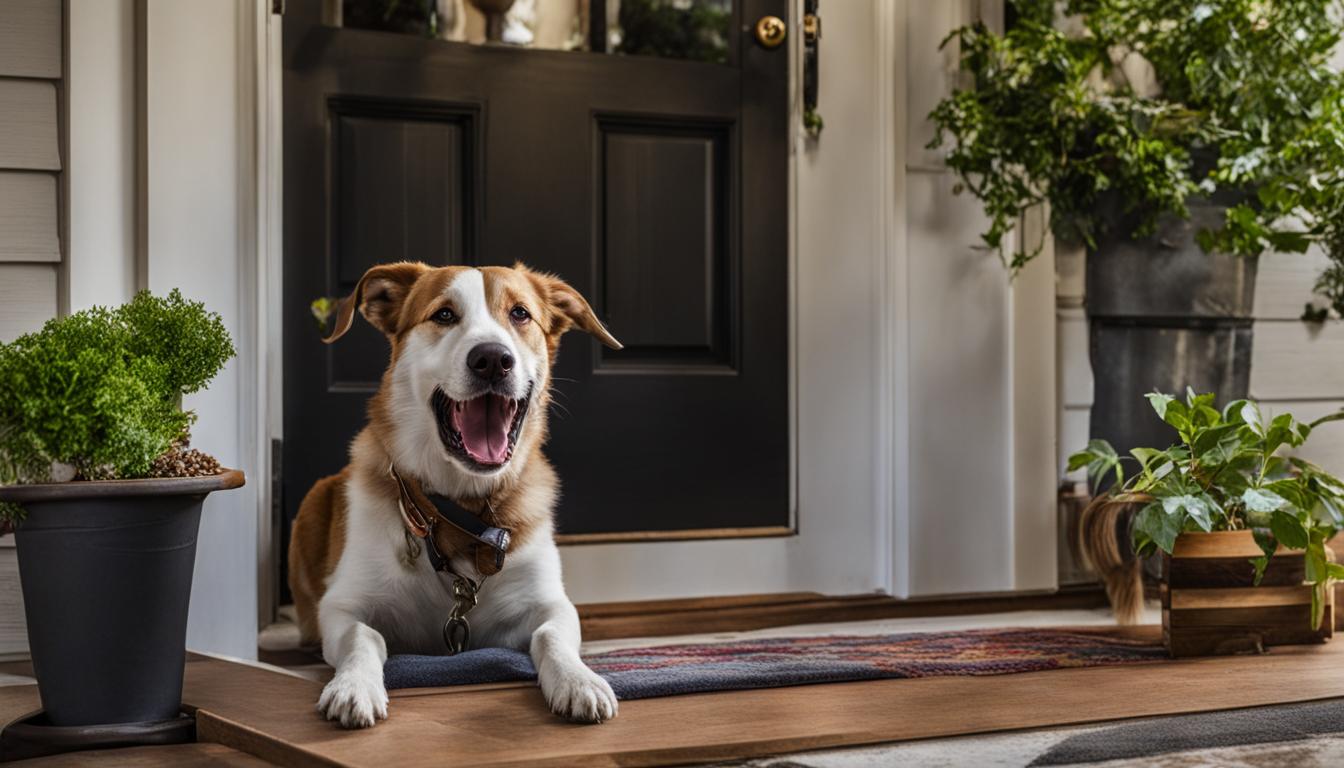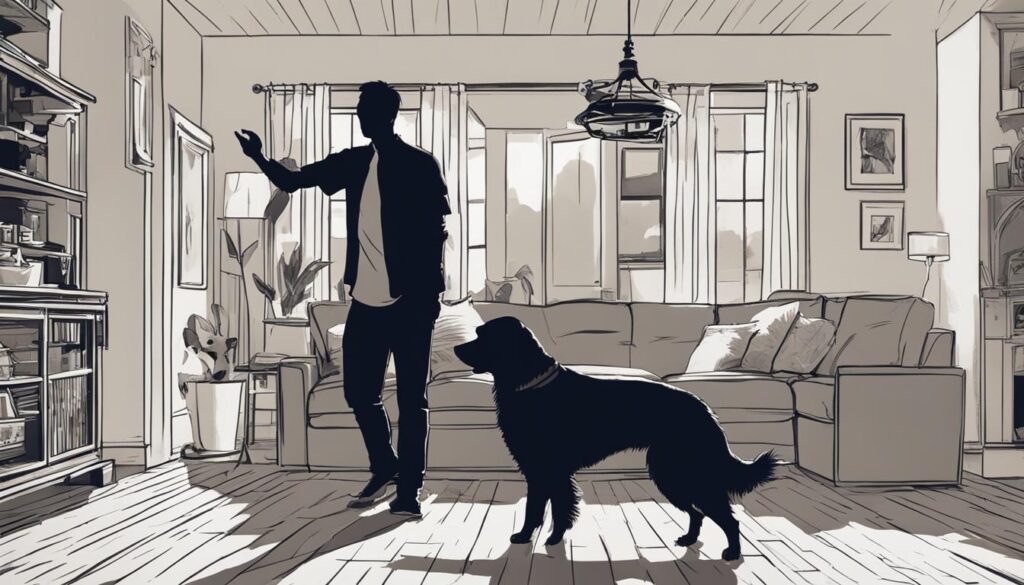
As a dedicated pet parent, I know how unsettling the incessant sound of a pooch barking can be. Not just for me, but for the entire neighborhood. Dogs, our faithful companions, communicate in many ways, and barking is one of their primary methods. However, when I find myself coping with excessive dog barking at home, it’s crucial to understand that this behavior can be modified. My goal is to help you learn how to curb your dog’s barking habit and stop your dog from barking at home without stress, reinforcing the serene environment we all cherish.
Let’s embark on this journey together as I share insights and strategies that will not only enhance our quality of life but also foster a deeper connection with our furry family members through effective communication and understanding.
Key Takeaways: Excessive Dog Barking at Home
- Identify the key reasons for dogs barking excessively in the home.
- Discover effective methods to curb the barking habit of your beloved pet.
- Utilize practical steps to maintain a peaceful home by stopping your dog from barking excessively.
- Understand how addressing excessive barking can improve your relationship with your dog.
- Learn about providing your dog with a reliable structure and training to manage barking behavior.
- Understanding Excessive Dog Barking at Home
- Common Triggers of Excessive Barking at Home
- WHAT CAUSES Excessive Dog Barking at Home AND HOW TO STOP IT
- Assessing Your Dog’s Barking Habits
- Beginner-Friendly Training Techniques to Reduce Barking
- Professional Help: When to Seek a Dog Trainer
- Excessive Barking Solutions: From Tech Gadgets to Calming Aids
- Creating a Calm and Quiet Home Environment
- Conclusion: Excessive Dog Barking at Home
Understanding Excessive Dog Barking at Home
When it comes to understanding dog barking reasons, it’s essential to recognize that barking is an intrinsic part of canine behavior, instrumental in communication. How do we, as pet owners, differentiate between normal barking and an excessive barking issue that needs addressing? Seeking effective excessive barking solutions begins with comprehension of the causes of such vocalization tendencies.
Let’s delve into some underlying factors contributing to this behavior:
Communicative Barking in Dogs
Barking can serve as an alarm, a greeting, or a response to environmental cues. For instance, when the doorbell rings, our canine companions often bark to alert us of a visitor’s presence. This type of communicative barking is natural, but it can escalate to problematic levels without proper dog barking control techniques.
The Impact of Breed on Barking Tendencies
Some dog breeds have an inherent disposition to bark more than others. Breeds that have been historically used for activities such as herding or guarding may be more prone to vocalize. For example, Beagles and Collies are known for their vocal nature due to their breeding backgrounds, which may result in a tendency to bark more frequently.
Emotional States Leading to Increased Barking
Emotional triggers like excitement, anxiety, or boredom can also lead to a surge in barking activity. Understanding our dogs’ emotional health is vital in implementing excessive barking solutions tailored to their needs.
In order to comprehend and control excessive barking effectively, let’s take a look at a comparison of common traits across different breeds that may influence their barking behaviors:
| Breed | Historical Role | Likelihood to Bark | Suitable Control Technique |
|---|---|---|---|
| Beagle | Hunting | High | Distractive Toys |
| Border Collie | Herding | Moderate to High | Physical Exercise |
| Rottweiler | Guarding | Moderate | Obedience Training |
| Shih Tzu | Companion | Low | Socialization Exercises |
Recognizing the reasons behind our dogs’ barking not only facilitates a stronger bond between pet and owner but also paves the way for a peaceful coexistence. By integrating effective strategies and understanding the specific needs of our furry friends, excessive barking can be ameliorated, making for a serene home environment.
Common Triggers of Excessive Barking at Home
As I’ve worked with countless dog owners, I’ve come to understand that identifying and addressing the cause of their pet’s vocal outbursts can play a crucial role in the quest to prevent excessive barking. Uncovering the triggers that spur your furry friend into a barking frenzy is the key to applying the most effective dog barking control techniques.
External Stimuli and Dog Alerts
It’s no secret that dogs are highly alert and sensitive to their surroundings. A range of external factors can set off a barking episode in even the most well-behaved canine. But what exactly are these stimuli? Let’s break them down:
- Sudden, loud noises like thunder or fireworks
- The sight or sound of strangers approaching the home
- The presence or scent of other animals nearby
- Passing vehicles, particularly those with loud engines or sirens
- Visual changes in the environment, such as moving shadows or flashing lights
Minimizing exposure to such stimuli or desensitizing your dog through gradual training can play a pivotal role in keeping the excessive barking at bay.
Separation Anxiety as a Key Factor
Separation anxiety is one of the most significant and heart-wrenching triggers of incessant barking. When our dogs cannot cope with being alone, they may express their distress through continuous vocalization. Signs that your dog might be experiencing separation anxiety include:
- Barking that starts soon after you leave and continues until you return
- Destructive behavior targeted at doorways and windows
- Attempts to escape from the house or crate
- Pacing, drooling, or other signs of stress observed before departures
Combating separation anxiety often requires a combination of behavioral modification, environmental enrichment, and sometimes even medical intervention.

Please take a look at the table below, where I’ve highlighted some common barking triggers alongside strategies to ease the concern:
| Common Barking Trigger | Control Technique | Preventive Strategy |
|---|---|---|
| Strangers walking by | Teach the “quiet” command | Restrict window access |
| Other animals in the yard | Positive reinforcement for quiet behavior | Create a visual barrier in the yard |
| Noises from outside} | Desensitization to sounds | Soundproofing home areas |
| Being left alone | Conditioning to enjoy alone time | Leaving interactive toys for engagement |
By recognizing these triggers and thoughtfully implementing control techniques, you can create a more serene home environment and improve the quality of life for both you and your beloved dog.
WHAT CAUSES Excessive Dog Barking at Home AND HOW TO STOP IT
As a dog owner, my journey to understand and train a dog to stop barking has been insightful and sometimes challenging. It’s clear that excessive barking can stem from a variety of issues. Environmental triggers, such as the sight of other animals or passersby, often provoke loud responses. Behavioral concerns might include habits formed from lack of mental stimulation or previous living conditions. On occasion, a deeper medical problem could be the culprit, indicating that a visit to the vet is necessary.
To effectively learn how to stop excessive dog barking, one must first identify the cause. A consistent training regimen can make a world of difference, particularly when it includes commands specific for silence, such as ‘Quiet’ or ‘Hush’. If behavior persists, professional trainers offer a wealth of knowledge and resources to address and correct the underlying issues.
| Cause of Barking | Possible Solutions | Professional Assistance Needed? |
|---|---|---|
| Environmental Triggers | Limit visibility to outside stimuli, use of calming sprays or noise blockers | No, unless no improvement |
| Behavioral Issues | Establish a routine, engage in more physical activities, mental games | Possibly, if the behavior is deep-seated |
| Lack of Training | Implement commands and positive reinforcement techniques | Yes, for guidance and effective methods |
| Medical Problems | Consult with a veterinarian for a full assessment | Yes, to rule out and treat any health issues |
Patience and understanding are essential as we navigate the training process. Each step should be approached with empathy and care for our canine companions. By taking the time to understand and address the root causes, we set both our dogs and ourselves up for a quieter, more peaceful coexistence.
Assessing Your Dog’s Barking Habits
As a devoted pet owner, I’ve learned that finding excessive barking solutions starts with a deep dive into the dog barking reasons. It’s important to observe and note the patterns of your furry friend’s vocal expressions. Are they barking more at night, or is it during the day when the house is buzzing with activity? To crack this code, I’ve developed a habit tracking log, which you can use too. It helps to uncover the ‘whens’ and ‘whys’ behind each bark and whine.

With a detailed log, we can identify the specific scenarios that trigger our canines into a chorus of barks. It could be the ring of the doorbell, the sight of another animal, or even a change in their routine. By noticing these details, it becomes easier for us to craft tailored strategies to manage their barking behavior, turning a noisy household into a serene living space.
| Time of Day | Trigger | Intensity (Scale 1-5) | Duration of Barking | Response to Commands |
|---|---|---|---|---|
| Morning | Mail delivery | 4 | 3 minutes | Slow |
| Afternoon | Neighbor’s dog visible | 5 | 5 minutes | Non-responsive |
| Evening | People walking by window | 3 | 2 minutes | Responsive |
Carefully understanding these elements allows us not only to minimize the undesired barking but also to ensure our dogs are happy and stress-free. Each bark tells a story, and it’s my mission to interpret it and respond with love and effective training.
Beginner-Friendly Training Techniques to Reduce Barking
If you’re eager to train a dog to stop barking using approaches that are both effective and uncomplicated for beginners, you’re in the right place. These methods not only promote harmonious living but also enhance the bond between you and your canine companion. Let’s explore several techniques that can be applied immediately to pave the way for peaceful days and quiet nights.
Positive Reinforcement Strategies
I’ve found that one of the most successful ways to encourage good behavior is through the use of positive reinforcement strategies. Whenever my dog remains quiet in a typically triggering situation, I make sure to reward him. This could be with delicious treats, favorite toys, or even generous praise. The key is to make the rewards so enticing that they outweigh the satisfaction your dog gets from barking.
Utilizing Commands to Control Barking
Commands like ‘Quiet’ have served me well in curbing unwanted noise. Teaching these commands involves giving the instruction followed by positive reinforcement when your dog obeys. Consistency and patience are paramount here – it’s important not to get discouraged if your dog doesn’t pick up on it right away. Practice regularly, and soon you’ll see progress.
Interactive Toys to Distract and Engage Your Dog
It’s amazing how effective interactive toys can be in diffusing the energy that might otherwise fuel a barking spree. These toys keep my dog engaged both mentally and physically, making him less likely to bark out of boredom or frustration. Something as simple as a puzzle feeder or a toy that dispenses treats can provide a constructive outlet for that boundless canine energy.
| Technique | Method | Benefits |
|---|---|---|
| Positive Reinforcement | Reward silence with treats or praise | Encourages good behavior without punishment |
| Command Training | Teach and reinforce ‘Quiet’ or ‘Enough’ | Provides clear instructions to curb barking |
| Interactive Toys | Use toys to occupy and stimulate | Diverts attention from stimuli that cause barking |
Remember, while you embark on this journey to train your dog to stop barking, maintain a generous spirit of encouragement and recognize that all dogs learn at their own pace. With these accessible techniques, you’re setting up both yourself and your furry friend for success.
Professional Help: When to Seek a Dog Trainer
As I’ve worked with my own furry friend to curb his barking habits, I’ve realized that sometimes we need a bit more help than what DIY guides can offer. Seeking professional help for dog training becomes an important step when the situation is beyond our expertise, particularly if my dog’s barking continues unabated despite my best efforts.
Assessing the Need for Professional Training
It’s crucial to know when it’s time for expert assistance. I looked into specific signs that it might be necessary to seek a trainer. These include non-stop barking that indicates deep-seated behavioral issues, barking triggered by anxiety or fear that doesn’t subside, and when my own corrective actions have no substantial effect. In these scenarios, professional help in dog training can provide personalized strategies that are effective and humane.
Choosing the Right Trainer for Your Dog
Finding a trainer who aligns with my dog’s needs and my training philosophy is paramount. I prioritized seeking someone with credible certifications and positive client testimonials. Also, it’s important that they employ positive reinforcement methods, since I strongly believe that trust and respect are the cornerstones of successful dog training.
| What to Look For | Why It’s Important | Questions to Ask |
|---|---|---|
| Certifications | Ensures the trainer meets professional standards | “What certifications do you hold?” |
| Experience | Longer experience often translates to more skill | “How many years have you been training dogs?” |
| Specializations | Trainers often specialize in certain behaviors or breeds | “Do you have experience with issues similar to mine?” |
| Methods | Training methods should align with your beliefs and dog’s well-being | “What is your philosophy on dog training?” |
| References | Testimonials can provide insight into others’ experiences | “Can you provide references from previous clients?” |
In my journey, choosing the right trainer has been pivotal. It has not only helped to address my dog’s excessive barking but also enhanced our bond, as we both understand and communicate with each other better. If you’re in a similar boat, don’t hesitate to get that professional input; it’s a worthwhile investment in your dog’s future and your sanity.
Excessive Barking Solutions: From Tech Gadgets to Calming Aids
When my furry companion’s barking becomes a bit too enthusiastic, I know it’s time to look into dog barking control techniques and excessive barking solutions. It’s not just about peace for my ears, but also comfort and well-being for my pet. In my quest for quiet, I’ve discovered a range of tools that can help.
For starters, ultrasonic bark control devices like the WLCelite Barking Control Device have been a game-changer. These nifty gadgets emit a sound that’s inaudible to human ears but grabs my dog’s attention immediately, distracting him from the barking urges. It’s a humane way to interrupt the barking without any physical discomfort.
Another ally in my anti-barking arsenal is the anti-barking collar. Some people might be wary of these, but the newer models come with multiple settings to ensure they are gentle yet effective. They’re a part of a compassionate training routine rather than a one-stop solution.
Let’s not forget about the soothing influence of pheromone diffusers. Just plug one in, and it releases calming scents that mostly go unnoticed by me but can significantly reduce my dog’s stress-triggered barking. The same goes for calming supplements – they’re like a spa day wrapped in a tasty treat, helping my pooch mellow out and stay quiet.
It’s all about creating a serene atmosphere for my four-legged friend. With the right combination of technology and tender love and care, excessive barking doesn’t stand a chance in my home.
- Ultrasonic Bark Control Devices: Portable and harmless interruption of barking
- Anti-Barking Collars: Adjustable settings for safe and effective training
- Pheromone Diffusers: Stress-alleviating scents for a calmer environment
- Calming Supplements: Nutritional aid to promote peaceful behavior
Remember, the goal is to find humane and effective products to aid in controlling your dog’s excessive barking. Each option has its place, and sometimes it takes a little bit of experimenting to find the perfect fit for your canine friend. After all, our dogs depend on us to make the best choices for their health and happiness.
Creating a Calm and Quiet Home Environment
Amid everyday chaos, our homes serve as sanctuaries for ourselves and our pets. To ensure a serene atmosphere that discourages disruptive behavior like excessive barking, it’s crucial to focus on creating a haven that pacifies our canine companions. By adopting specific strategies, I’ve seen a substantial decline in my dog’s need to bark, thereby ensuring a peaceful coexistence.
Preventive Measures to Curb Dog Barking
Preventing excessive barking starts by identifying potential causes of noise that may trigger your dog. I’ve found success by incorporating soundproofing materials where my dog spends most of his time. This could be as simple as adding thick curtains, investing in a rug to absorb sound, or placing acoustic panels in barking “hot spots.” Establishing a reliable routine for play, feeding, and walks also brings predictability, which dogs love, and significantly reduces anxiety-induced barking.
Designing a Comfortable Space for Your Dog
Concurrently, ensuring comfort in my dog’s personal space is crucial. A dedicated and comfortable area matters immensely in making them feel secure and content. I made sure my dog’s retreat includes a cozy bed in a quiet corner, away from foot traffic and noise. Access to fresh water, his favorite chew toys, and a view of the window (if it doesn’t provoke barking) also contribute to his contentment, allowing me to prevent excessive barking driven by discomfort or boredom.
| Feature | Benefit |
|---|---|
| Soundproofing Elements | Reduces external noise triggering barking |
| Established Routine | Decreases anxiety and uncertainty |
| Cozy Bedding | Offers a sense of security |
| Toys and Puzzles | Provides mental stimulation |
| Fresh Water Availability | Keeps the dog well-hydrated and comfortable |
By meticulously curating these elements for a comfortable space for dogs, the incessant barking has been curtailed. It’s not just about a tranquil home for us, but it’s for them—our loyal companions too. Their well-being directly influences their behavior, and as responsible pet owners, it’s our job to provide that nurturing environment.
Conclusion: Excessive Dog Barking at Home
In my journey to curb my dog’s barking habit, I’ve learned that there is no one-size-fits-all solution. Each strategy and tool I’ve discussed is part of a broader approach to stop excessive dog barking. It’s about striking a delicate balance between training methods, management strategies, and making the right environmental adjustments for our canine companions. An important lesson was that each dog responds differently; what silences the boisterous bark of one may not necessarily quiet another.
As I integrated these solutions into our household, I noticed a gradual improvement in my dog’s behavior. Consistency proved to be key in reinforcing training techniques, and patience was certainly tested—but, the outcome was a more peaceful home. The bond with my dog grew stronger as we worked together towards a common goal, highlighting the beautiful dynamic that emerges from understanding and respecting our furry friends’ needs.
In essence, my experience underscores the essence of dedication in resolving any behavioral issue. For those embarking on a similar quest to curb dog barking habits, stay the course, and know that with each day of persistent effort, a serene and harmonious living space is entirely within reach. I hope this article serves as a guide and reassurance that you, too, can achieve tranquility in your home with your loyal, yet sometimes vocally exuberant, four-legged family member.













